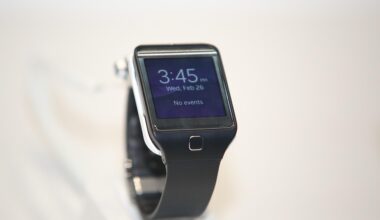Body Composition Apps and Their Role in Rehabilitation Programs
Body composition apps and software tools have emerged as invaluable resources within rehabilitation programs. By offering precise metrics on various aspects of body composition, these tools provide essential data that can guide personalized recovery strategies. Rehabilitation professionals utilize these applications to monitor fat mass, lean muscle mass, and hydration levels, allowing for more tailored interventions. Utilizing these insights, therapists can make informed decisions about exercise prescriptions and nutritional guidance. Thus, tracking body composition facilitates a more dynamic approach to recovery, ensuring that individuals achieve optimal health outcomes. One major advantage of these applications is their ease of use and accessibility. Many of them are available as mobile apps, which patients can conveniently use at home. This promotes accountability, encouraging users to monitor their progress independently. Regular tracking can lead to improved adherence to rehabilitation programs, as patients visibly see the impact of their efforts. Additionally, these apps often come with educational resources, providing users with valuable information to promote better lifestyle choices. Overall, body composition apps significantly enhance the effectiveness of rehabilitation programs by continuing to engage individuals in their health journey.
Rehabilitation programs aim to restore function and improve quality of life for individuals recovering from injuries or surgeries. Body composition analysis plays a critical role within these programs, offering insights into how a patient’s physical state evolves over time. Real-time data allows healthcare providers to adjust treatment regimens based on the patient’s progress, ensuring that rehabilitation goals align closely with actual physical capabilities. Furthermore, having tools that deliver immediate feedback helps in addressing any potential setbacks promptly. For instance, if a patient’s body fat is incongruently increasing while muscle mass decreases, this could indicate the need for reevaluation of their dietary practices or exercise routine. Moreover, body composition apps foster a collaborative environment between patients and healthcare providers, as both parties can visualize the data indicating progress or areas needing attention. This collaboration can enhance patient motivation and commitment to recovery processes. Many patients often feel disengaged from their own rehabilitation efforts, but these applications offer tangible proof of the changes occurring. Consequently, they engender a sense of ownership over one’s health and recovery journey, enhancing overall satisfaction with the rehabilitation experience.
Benefits of Body Composition Apps
Body composition apps are invaluable for increasing awareness surrounding fitness and health. These applications can effectively break down complex data into digestible insights, making it easier for users to understand their physical health metrics. Many of these tools offer user-friendly interfaces that make tracking changes over time intuitive and engaging. The ability to observe trends and milestones can be motivational for users, encouraging them to stick with a rehabilitation program. In particular, when users receive instant feedback regarding their body composition, it reinforces positive behavior and fosters a deeper commitment to achieving their goals. It’s also essential to highlight that many body composition apps provide tailored recommendations based on individual profiles. These recommendations can align with specific rehabilitation objectives, ensuring a targeted approach that considers the user’s unique circumstances. Enhanced nutrition guidance is another critical aspect of these applications. By encouraging users to log their food intake, they can visually correlate how their dietary habits affect body composition outcomes. This education empowers users to make smarter food choices, ultimately leading to improved recovery rates and a healthier lifestyle after rehab.
Incorporating body composition apps into rehabilitation programs not only aids patients physically but also mentally. The psychological component of recovery cannot be underestimated, as consistent progress tracking can significantly enhance a patient’s confidence and motivation. Seeing tangible evidence of changes in body composition can boost self-esteem, making individuals feel better about their bodies and their capabilities. This is particularly important for patients recovering from injuries that may have altered their perception of self-worth. Furthermore, many of these applications allow individuals to connect with a community of users, creating an additional layer of social support. Sharing success stories or challenges with peers can help alleviate feelings of isolation during rehabilitation. These communities encourage sharing advice and tips regarding physical health, thus creating a collaborative approach to recovery. For example, learning from others who may be experiencing similar challenges can help patients feel understood and less alone. It can promote engagement with the rehabilitation process by fostering connections that enhance adherence to exercise and dietary recommendations.
Challenges and Considerations
While body composition apps present many benefits, there are also challenges and considerations to keep in mind. One of the key challenges includes ensuring the accuracy and consistency of the data provided by the tools. Users may overlook how factors like hydration status can influence their readings, leading to misconceptions about their body composition. Therefore, it’s crucial for patients to consult with healthcare professionals who can help interpret data correctly. Furthermore, reliance solely on app data without comprehensive guidance or support can lead individuals astray. Users must balance technology’s insights with holistic approaches encompassing physical therapy and general wellness. Another major concern is technology accessibility. While many people have smartphones, there are still populations that may not have access to these digital tools. It’s essential to ensure that body composition evaluation remains equitable, providing all patients with the opportunity to take advantage of these resources. Lastly, recommendations generated by apps should not replace personalized guidance from qualified practitioners. Ensuring a collaborative approach between technology and personal care can yield the best outcomes.
The future of body composition apps within rehabilitation programs appears bright. As technology advances, we can expect even more sophisticated features that enhance user engagement and accuracy. For instance, incorporating wearable technology alongside body composition apps could offer real-time data collection and analysis. Such integration would enable a comprehensive understanding of how physical activity impacts body composition, facilitating better-informed rehabilitation strategies. Additionally, as app developers continue to understand user needs, we may see enhanced predictive analytics that can anticipate body composition changes based on various factors like dietary inputs and activity levels. These innovations promise to further personalize recovery programs, thus maximizing their effectiveness. On the other hand, ethical considerations regarding data privacy and user consent must be taken seriously. As health data becomes increasingly digital, the potential for breaches grows. Ensuring strict confidentiality and secure data handling practices will be essential to fostering patient trust. Ultimately, as body composition apps continue to evolve, they will play an even more significant role in transforming rehabilitation practices, leading to improved patient outcomes and enhanced healthcare experiences.
Conclusion
In summary, body composition apps and software tools have become essential assets in rehabilitation programs. Their ability to provide actionable insights into body composition empowers both patients and healthcare providers to make informed decisions regarding recovery strategies. With built-in educational components, these applications enhance individual knowledge about nutrition and fitness, fostering informed decision-making around health. Additionally, the motivational aspects of tracking progress can contribute significantly to adherence, making patients more engaged in their recovery journeys. Challenges exist, primarily around data interpretation and access equity, but these can be mitigated through professional guidance and community support. Looking ahead, technological advancements will likely lead to more sophisticated features and integration capabilities with other health tech. As these tools continue to develop, their importance and applicability in holistic rehabilitation models will only grow stronger. By combining technology with compassionate care, we set the stage for an era where rehabilitation can be more personalized, effective, and encouraging. In doing so, we not only improve physical health outcomes but also contribute to healthier, more confident individuals ready to thrive.


